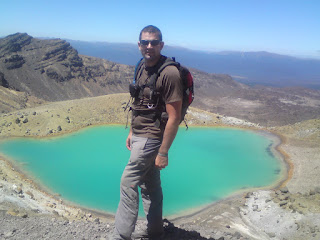
The extent of the recent bush firers (many of which are still burning), was evident as we exited Melbourne to the east – the sky was hazy and the hills in the distance a pale grey silhouette. Our plan was to make it over to Lakes Entrance, and I thought it would be interesting to loop down to follow the coast road. The trouble is that the coast road is rarely near enough to the coast to actually see it, and instead you get an extra two hours of driving through god-forsaken towns.

Lakes Entrance is a quaint little town, with a foot bridge over the lagoon to the sand spit of Ninety Mile Beach. We bought fish 'n' chips (or in my case veggie burger 'n' chips), with the intention of eating them on the lagoon front. However, predictably enough, within two seconds of opening the bag, twenty sea gulls descended with their beady eyes straight out of a Hitchcock film. We retreated to the safety of the hostel.

The next day, making no unnecessary detours, we crossed the boarder back into NSW, and made straight for Eden, and its Killer Whale Museum (the woman let us in for half the normal $12 admittance because it was 35 minutes from closing, but quirky as it is, 20 minutes is enough). The beach at Eden fairly good, one you've had your fill of Whale stories.
 Our finally destination was Merimbula, just north of Eden. A little before dusk, the local Kangaroo population make their way to the caravan park and housing estate to graze on the front lawns. At one point I counted 50 or so munching away in what was otherwise a normal suburban setting (of course it is normal for round here, just odd for us). When approached the entire mob will stand up and stare in the same direction, rather like a troop of oversized meerkats. The Kangaroos can also be seen keeping the grass short on the golf course.
Our finally destination was Merimbula, just north of Eden. A little before dusk, the local Kangaroo population make their way to the caravan park and housing estate to graze on the front lawns. At one point I counted 50 or so munching away in what was otherwise a normal suburban setting (of course it is normal for round here, just odd for us). When approached the entire mob will stand up and stare in the same direction, rather like a troop of oversized meerkats. The Kangaroos can also be seen keeping the grass short on the golf course.
We'd planned to spend the last night before returning to Sydney in Jervis Bay. Unfortunately Jervis Bay was playing host to a large triathlon over the weekend, which had hoovered up all the accommodation. So after a quick look around, we carried on to Wollongong. This was somewhat of a mistake, and we found ourselves checking in to a YHA that was part of the university halls of residence. I'm sure the place has its charms, but we needed to be back in Sydney early, so didn't really hang around to find them.

















































